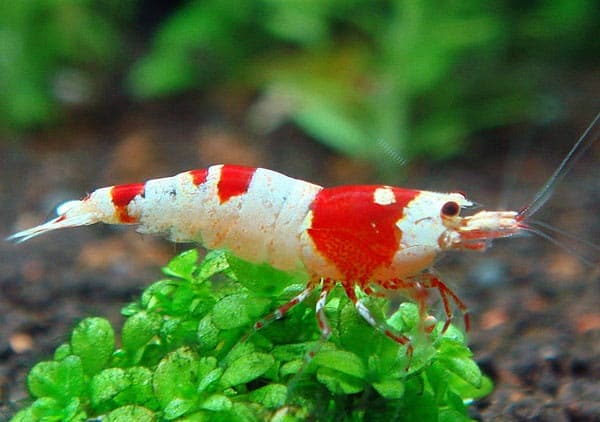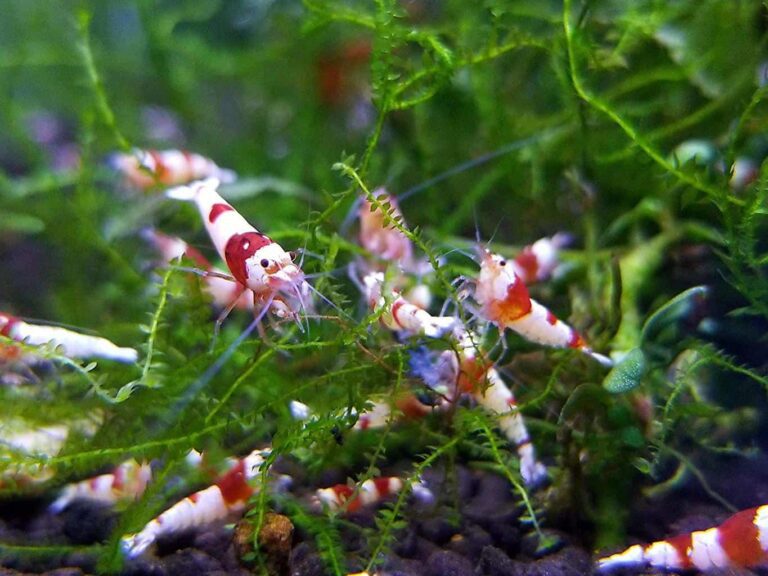Crystal red shrimp is the new buzz in the aquarium world with its vibrant red and white color combination. Naturally, aquarium hobbyists are running after the CRS (crystal red shrimp) like crazy. However, with such craziness, amateur aquarists are having some problems.
One such problem arises when the shrimp owner first see their pet shredding the exoskeleton for growth. Well, it is known as molting. Don’t get scared, it’s not a diseases and the shrimp is not dead if that is what you are wondering!
But now you may ask the obvious question – how often do crystal red cherry shrimp molt?
We have found that crystal red shrimp will molt almost every week in its juvenile stage, but as they grow, the molting process will slow down. An adult CRS will molt every four to six weeks.
Now let’s see the different stages of crystal red shrimp molting along with how to promote or slow down the molting process.

What is Molting?
To put it merely, molting refers to the shredding of the outer shell of the shrimp to achieve a bigger physique. Since the solid shell structure of a shrimp obstructs its growth, the shrimp puts off its shell to grow bigger.
To understand it fully, at first, you need to understand crystal red shrimp physical structure.
Shrimps are invertebrates and have a robust exoskeleton.
An exoskeleton is made of 20%-30% chitin, 30%-40% protein, and 30%-50% calcium carbonate. All these elements form a solid external shell that is referred to as an exoskeleton. While it prevents the shrimp from external harms, it also limits the growth.
Thus, each time a shrimp grows more prominent, it starts molting. In fact, all shrimps go through the molting process. Check this article about the molting of red cherry shrimp.
How Often Crystal Red Shrimp Molt?
Shrimp molting frequency is dependent on its age. When it is in the larva state, it will molt every day (almost with rare irregularities). As it grows with every day, the molting process slows down, and when it reaches adulthood, it will molt once every four to six weeks.
The molting frequency of the crystal red shrimp is described in the following table according to its age.
| Shrimp Age | Larva | Post-larva | Juvenile | Adult shrimp |
| Molting percentage in entire lifespan | 40%- 55% | 15%-25% | 5%-10% | 10%-20% |
| Molting frequency | Almost everyday | Twice in a week | Once in 7-10 days | Once in every 4 to 6 weeks |
As you see in the table, at the larva stage, a crystal red shrimp happens to face most of his molting frequency. Also, as it advances to the next level, the molting period is extended.
If you want to understand how each molting stage occurs, read through the next section. It will help you realize the molting procedure better and improve the shrimp during the process.
Four Stages of Crystal Red Shrimp Molting:
A crystal red shrimp molting has four stages. These are:
- Pre-molt
- Molt
- Post-molt
- Inter-molt
Each of these molting stages has distinctive features, and the shrimp features various characteristics during these stages.
The Pre-molt period:
At this time, the shrimp takes preparation for the main molting. It starts with the growth of the new exoskeleton under the older one. Also, the new exoskeleton will consume approximately 20% to 30% calcium carbonate of the existing shell.
At the pre-molt period, the shrimp eat less, and it will become more intense as the molting period comes close.
The Molting period:
The shrimp behavior changes considerably as it advances towards the molting stage. You will see the shrimp vigorously pumping water. As it pumps the water, the older exoskeleton reaches towards the breaking point.
But it isn’t fully broken at this stage.
The shrimp will stop moving and eating at this period and will receive its required nutrients from the old outer shell.
The inter-molting period:
The crystal red cherry shrimp remains the most vulnerable during this stage. So, you need to heavily pay extra attention to the shrimp at this time.
During the inter-molting period, the old exoskeleton is at the brink of breaking point, but it’s not entirely broken. Also, the new exoskeleton is very soft, and so, the crystal red shrimp is in a standstill condition to prevent injuries.
The post-molting period:
As you may guess, at the beginning of the period, the shrimp leaves the exoskeleton and braces the new one gleefully. The new exoskeleton still is a bit soft, but within a few hours, it becomes rock solid.
It lasts around 18 hours to 36 hours.
Also, you will see the shrimp forming a U-shape.
As the shrimp entirely resembles a U-shape, the old shell breaks down into pieces, and the new ones emerge. And you will see a slightly bigger crystal red shrimp.
During this period, the shrimp’s appetite enhances unimaginably. Hence, you will need to provide extra food to the shrimp at this stage.
What Happens During the molting stage?
A crystal red shrimp goes through various ups and downs during the entire molting period. However, most visible behavioral and physical changes happen during the post-molting period. These happenings are:
- Initially, the newly formed exoskeleton remains softer. So, the shrimp won’t move at this time to prevent injuries.
- The newly formed exoskeleton will look dull and less vibrant at the beginning. With time, the shrimp will regain the vibrancy.
- You will see an increased appetite for the shrimp.
- The shrimp will gain some weight, only slightly though. It will take only a few grams.
- During the entire molting stage, crystal red cherry shrimp engulfs water vigorously. So, if you take its weight measurement, you may see even a 3% to 7% increased body mass. But it comes to natural condition once the molting stage is over.
What Problems Occurs During the Crystal Red Shrimp Molting?
Timely molting of the shrimp is a sign of healthiness. So, you should be pretty happy when you see the shrimp molting.
However, not everything is a merry journey.
Yes, you read it right- several problems may occur during the molting stage. And all these happen since the shrimp is vulnerable at this time.
Nonetheless, there are two most crucial and dangerous problems regarding inappropriate molting.
These are described below:
Getting stuck within the molt:
If you ever noticed the crystal red shrimp lying motionless like a dead one or severely twitching, it’s not a joyous sight.
The motionlessness or twitching is a sign that the shrimp is accidentally stuck within its old shell.
How dangerous!
It happens mainly because the old exoskeleton fails to breakdown at the right spot and right point. Usually, the exoskeleton breaks right behind the head at the joint.
But when it happens in other parts of the body, the shrimp get stuck between the shell. At this time, you need to act fast.
Find tweezers and hold the shrimp carefully to remove the exoskeleton slowly. Be sure you don’t catch the shrimp too tightly as to hurt or injure it.
White death of ring:
The name may sound romantic, but it’s a death sign for your favorite shrimp.
The white death of the ring occurs when the older exoskeleton breaks abruptly in two points instead of the one point- right behind the head.
If it occurs, the crystal red shrimp feels stressed and tries his best to get rid of the problem. Unfortunately, you can’t do anything when it happens.
It is a death sentence for your favorite CRS!
Ways to avoid molting problems:
You see that a crystal red shrimp faces two issues during the molting period. Furthermore, at least one of them brings the eventual death of the shrimp. So, obviously, you would want to avoid such hazardous conditions.
But how do you stop molting problems?
While there are the least you can do, we recommend you to maintain the aquarium water in an optimal state to reduce such occurrences.
The optimal water parameters for crystal red shrimp are listed below:
| Components | Optimal Range |
| pH level | 7-8 |
| Total Dissolved Solids (TDS) | 150-200 ppm |
| General Hardness (GH) | 60-120 ppm |
| Carbonate Hardness (KH) | 60-250 ppm |
| Nitrite and Nitrate | 0 ppm |
| Light hours | Approximately 6-8 hours |
| Water Temperature | 65°F-75° (22°C-26°C) |
Once you can maintain the parameters quite well, the chances of problems during molting will reduce considerably. Also, you should feed the shrimp with proper food.
The proper nutrients for red crystals include adequate balancing between protein and carbohydrate. Ideally, it refers to more protein during the juvenile stage and more carbs during adulthood. Some of the nutritious food items for shrimp are-
- Kale
- Algae wafers
- Zucchini
- Bio-film
- Commercial shrimp protein
Can You Boost Molting?
If you are a shrimp breeder and sale crystal red shrimp for commercial purposes, you would want it to grow faster. And since the growth is relatable with the molting, you would want to boost the molting. But can you do so?
Yes, if we are to answer it simply, you can boost the crystal red shrimp molting.
Luckily, you won’t require mastery in doing so. Instead, you may follow the below-listed techniques for it.
- If you can maintain the water parameters always, it should help to increase the molting a bit slightly.
- Proper nutrients will also boost the molting. Also, it helps the shrimp grow smoothly.
- Lastly, the most effective method is to increase the water temperature only slightly to boost the molting. With increased water temperature, the shrimp metabolism increases the lifts of the molting. Similarly, you can reduce the molting frequency by decreasing the water temperature.
What to do with the shrimp molt?
Many people ardently remain confused about what they should do with the molt or older exoskeleton.
Well, just ardently leave it as it is in the aquarium.
Yes, there’s nothing you need to do with the shrimp molt. It consists of nutrients and calcium carbonate. So, the shrimp actually eats the exoskeleton to get a quick, nutritious feed. And it’s perfect since it is brimming with protein.
Final Words
So, here’s the answer once again of the questions, ‘how often do crystal red shrimp molt?’
You will see the larva molting once per day, two times per week in the juvenile stage, and once in four to six weeks when grown-up fully.
The frequency slows down since after achieving adulthood, the shrimp doesn’t grow bigger anymore, neither in physical shape nor in weight. However, during the juvenile and youth stage of the shrimp, you can increase the aquarium water temperature to boost the molting frequency.
That’s all for today from us.






